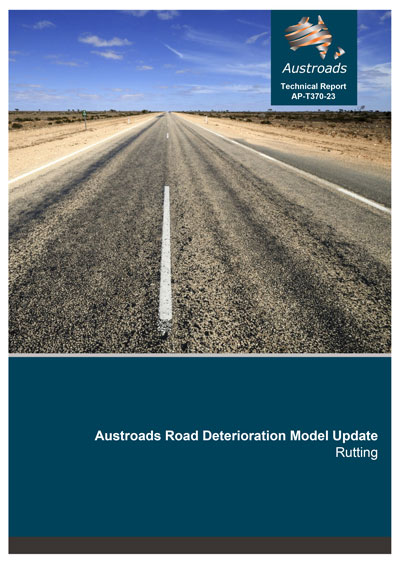Pavement

- Publication no: AP-T370-23
- ISBN: 978-1-922700-70-4
- Published: 20 January 2023
- PDF (free) Download
This report documents a project designed to update the current Austroads road deterioration (RD) models using the long-term pavement performance and long-term pavement performance maintenance (LTPP/LTPPM) dataset and other data available, such as the traffic speed deflectometer (TSD) datasets, to improve these models’ explanatory power. A proof-of-concept approach based on using the available TSD datasets undertaken early in the project determined that these datasets were not appropriate at this stage for developing an updated rutting RD model.
The rutting RD model was based on a mechanistic-deterministic approach using a multi-variate non-linear regression analysis. The rutting RD model uses cumulative rutting as the dependent variable for thinly surfaced flexible unbound granular pavements using the Austroads LTPP/LTPPM dataset collected from 1994 to 2018. The rutting RD model may need some calibration to suit locally observed rutting conditions using a calibration coefficient, Kr.
The model also has the capacity to be adapted to surface maintenance treatments other than double/double seals to determine their impact on cumulative rutting by using relative performance factors for surface maintenance treatments. The model was validated using an independent dataset.
Watch a webinar with Dr Tim Martin, Ranita Sen and Tyrone Toole for an overview of the development of the four road deterioration models.
- Summary
- 1. Introduction
- 1.1 Background
- 1.2 Purpose
- 1.3 Scope
- 1.4 Methodology
- 2. Literature Review
- 2.1 Overview
- 2.2 Pavement Performance
- 2.2.1 Limit of Gradual Deterioration
- 2.3 Assessment of Pavement Performance
- 2.3.1 Functional Performance Measures
- 2.3.2 Structural Indicators
- 2.4 Review of Recent Modelling Practice
- 2.4.1 Typical Modelling Approaches
- 2.4.2 Machine Learning with Big Datasets
- 2.4.3 Application of ML to Pavement Deterioration Modelling
- 2.5 Selection of Appropriate Modelling Approaches
- 2.5.1 Expected Modelling Approach
- 2.5.2 Proof of Concept for TSD Datasets
- 3. Data Review
- 3.1 Data for Analysis
- 3.2 Data Requested from Road Agencies
- 3.3 Review of the Data from Australian Road Agencies
- 3.3.1 Transport for New South Wales (TfNSW) Data
- 3.3.2 Queensland Department of Transport and Main Roads (TMR) Data
- 3.3.3 Main Roads Western Australia (MRWA) Data
- 3.3.4 Department of Planning, Transport and Infrastructure (DPTI) South Australia Data
- 3.3.5 Department of Infrastructure, Planning and Logistics (DIPL) Northern Territory Data
- 3.3.6 Department of State Growth (DSG) Tasmania Data
- 3.3.7 Summary of Road Agency Data Supplied
- 3.4 Missing Data for RD Model Development
- 3.4.1 Climate Information
- 3.4.2 Soil Reactivity
- 3.4.3 Sub-soil Drainage Information
- 3.5 Review of the LTPP/LTPPM Data
- 3.5.1 Overview of Austroads LTPP/LTPPM Data
- 3.5.2 Usability of Austroads LTPP/LTPPM Data
- 3.5.3 Usability of New Zealand LTPP Data
- 4. Development of the Rutting RD Model
- 4.1 General Approach and Limitations
- 4.1.1 Data Summary
- 4.2 Treatment of Independent Variables
- 4.3 Development of the Rutting RD Model
- 4.3.1 Design Deflection D0 based on the D0/D0i Structural RD Model
- 4.4 Cumulative Rutting, ΣΔrut, RD Model Development
- 4.4.1 Modelling Concept
- 4.4.2 The Cumulative Rutting, ΣΔrut, RD Model
- 4.4.3 Annual Incremental Rutting
- 4.4.4 Comparison with Austroads 2010 Rutting RD Model
- 4.5 Validation of the Cumulative Rutting RD Model
- 4.5.1 Analysis Steps
- 4.5.2 Findings
- 4.5.3 Potential for Further Refinement of Cumulative Rutting Prediction
- 4.1 General Approach and Limitations
- 5. Conclusions
- References
- Appendix A Development of Relative Performance Factors
- A.1 Relative Performance Factors for Maintenance
- A.2 Relative Performance Factors for Increased Axle Loads
- Appendix B Multivariate Non-linear Regression Analysis Outputs
- B.1 Cumulative Rutting, ΣΔrut, RD Model
